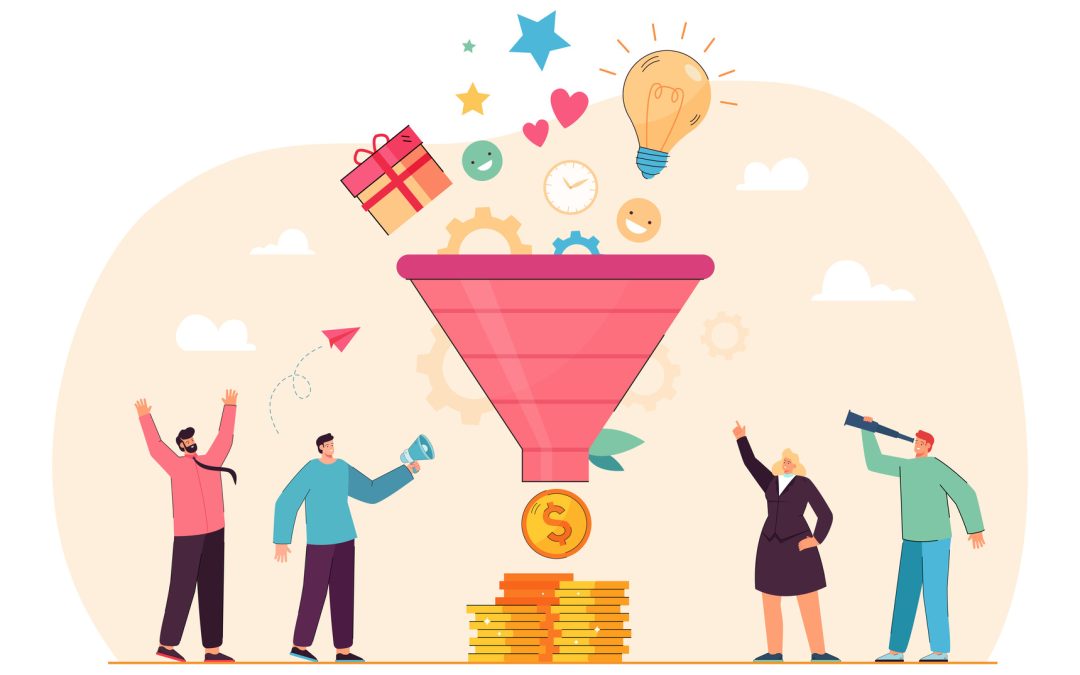Businesses need to constantly improve their plans to turn leads into loyal customers in today’s competitive industry. Managing the sales funnel is now a significant way for businesses to make their sales processes more efficient and get as many people as possible to buy. Businesses may assist prospects through each stage of their journey by effectively managing the sales funnel. This makes it more likely that deals will be closed and revenue will increase. Businesses may turn potential leads into loyal clients by giving them the correct information at the appropriate time.
What is the management of a sales funnel?
A sales funnel is a picture of the steps a customer takes from the time they first hear about your product or service to the time they buy it. Managing a sales funnel means carefully leading potential customers through the many steps of the funnel. This management approach makes sure that prospects are taken care of at every stage, which increases the chances of conversion and maximizes income.
Managing your sales funnel well is important because it gives organizations a clear way to approach their sales process in a way that is both systematic and optimized. Businesses can improve their sales efforts and make better use of their resources by keeping track of and nurturing leads. This makes it more likely that they will close deals quickly.
What is the importance of managing a sales funnel?
You can’t stress enough how important it is to manage your sales funnel. It has a number of unique benefits for companies who want to make their sales process better:
1. Find Good Leads
Businesses may find leads that are most likely to convert by carefully looking at where each lead is in the funnel. By putting your resources into leads with a lot of potential, you can make your sales efforts more successful and focused instead of spreading them too thin.
2. Take good care of your leads
A well-organized sales funnel makes sure that leads get the right care. Businesses may make it more likely that leads will become paying customers by giving them the correct information and help at each stage.
3. Make sales processes better
Businesses can find problems and places for development by regularly looking at how the funnel is doing. Sales funnel management lets you keep improving processes, which makes sales operations run more smoothly and more efficiently.
4. Raise the rates of conversion
With well-managed sales funnels, firms may make it more likely that leads will reach the last stage of the funnel, when they buy something. Properly directing leads at every level can help you close more deals and make more sales.
The Steps of a Sales Funnel
To run a sales funnel well, you need to know what each stage means. The funnel’s different levels show the different steps a buyer takes on their journey. At each level, businesses need to change how they do things based on the specific demands and actions of prospects.
1. Stage of Awareness
At the awareness stage, people initially learn about your brand or product. They can be having a problem or pain point and start looking for ways to fix it.
Important Strategies for the Awareness Stage:
Marketing using Content: Make blog entries, videos, and social media postings that talk about the challenges that most of your target audience has. These pieces of content will get people’s attention and get them to interact with your brand.
Search engine optimization (SEO) is the process of making sure that your content ranks high on search engines. This will make it more visible and provide more organic traffic to your website. Use SEO methods to improve the landing pages, blog posts, and product descriptions.
Paid Advertising: Ads that you pay for on sites like Google Ads and social media can help people learn about your business and get to your site. You can make sure your information gets to the correct people by carefully choosing keywords and demographics.
2. Stage of Interest
When a potential customer knows about your brand, they move on to the interest stage. At this point, customers start to interact with your content more and learn more about what you have to offer.
Important Steps for the Interest Stage:
Lead Magnets: Give potential customers free trials, ebooks, webinars, or other useful tools to get them to give you their contact information. These tools help people trust you and get closer to making a purchase.
Email campaigns: Use email marketing to send leads useful information, updates on your products, and communications that are tailored to them. This keeps your brand in people’s minds and makes it more likely that they will buy from you.
Social Proof: To build trust and show how your product or service has helped others in similar situations, share customer reviews, case studies, and success stories.
3. Stage of Choice
At this point, potential customers are deciding whether or not to buy. They have fewer choices now and are looking at your offer next to that of your competitors.
Product demos or trials are two important strategies for the decision stage. Giving free trials or product demos lets potential customers see how your product might help them. This stage shows value and helps turn prospects into customers.
Personalized Communication: Make sure your messages are tailored to the needs of each prospect. Show them how your product or service may help them reach their goals or solve their specific difficulties.
Limited-time discounts or special offers are examples of incentives that can make people feel like they need to act quickly, which can help them make a decision faster.
4. Stage of Action
The last step in the funnel is the action stage, when leads become customers by making a purchase or signing a contract.
Key Strategies for the Action Stage: A faster checkout process: Make sure that buying things is easy, clear, and without any problems. A checkout process that is easy and trouble-free makes it more likely that people will follow through and buy something.
Follow-Up Communication: When a potential buyer is almost ready to make a purchase, get in touch with them right away to answer any last-minute inquiries and encourage them to clinch the sale.
After-Purchase Engagement: After a consumer buys anything, send them individual thank-you letters, offer customer support, and ask for feedback. This helps you make long-term connections and get repeat business.
How to Manage Your Sales Funnel the Right Way
To run a sales funnel well, you need to keep optimizing and watching it. Businesses can make their sales funnel work better and get more people to buy by following these best practices.
1. Keep an eye on and study the data
Regularly check and analyze data from each step of the sales funnel to find ways to make things better. Some important things to keep an eye on are:
Conversion Rates: Find out how many leads go from one step to the next and where they drop off.
Lead Velocity: Keep an eye on how rapidly leads travel through the funnel. This helps you make the best use of your time and make sure that prospects are cared for properly.
Lead Quality: Check the quality of leads that come from different marketing channels. Focusing on high-quality leads will help you close more deals and make your sales process more efficient.
2. Make Sales Funnel Tasks Automatic
Using automation tools like CRM software can make managing your sales funnel much more efficient. These tools can handle important duties like keeping track of leads, sending out emails, and sending out reminders to follow up.
Things to think about when choosing CRM tools:
HubSpot is one of the best CRM platforms. It has tools for managing leads, sending emails, and analyzing data.
Salesforce is one of the most prominent CRM systems. It helps firms automate their sales process and gives them a lot of information about how leads act.
Pipedrive is a simple yet powerful CRM application that helps sales teams keep track of and handle leads more effectively.
3. Section Your Leads
Segmentation is the most important thing to do to make sure your messages are relevant and on target. Not all leads are the same, thus you should group them depending on certain factors, such as:
Lead Source: Where the lead came from, such paid ads, organic search, social media, etc.
Behavioral Data: Keep an eye on what a lead does on your website, including downloading content, signing up for a demo, or clicking on product links.
Demographics: Break down leads by things like firm size, industry, job role, and location so you can send them messages that are more relevant to them.
4. Put your attention on Lead Nurturing
To keep prospects interested throughout their journey, lead nurturing is very important. Some good ways to nurture leads are:
Send prospects useful information, product updates, and personalized offers on a regular basis to keep them interested.
Personalized Outreach: Based on how leads interact with your website and content, send them messages that are specific to them. This makes it more likely that people will convert because it meets their wants.
Social Media Engagement: Talk to potential customers on social media, answer their questions, and give them useful information through postings and interactions.
Things You Shouldn’t Do in Your Sales Funnel
Even though it has a lot of potential, companies can still make mistakes that make their sales funnel management less efficient. To make your funnel work better, don’t do these typical mistakes:
1. Not paying attention to the Awareness Stage
If you don’t take care of leads in the awareness stage, you could miss out on chances. Your brand could not get enough leads to fill the top of the funnel if you don’t have a strong plan to get the word out.
2. Not paying attention to lead segmentation
Personalized communication depends on segmentation. If you don’t segment your leads well, you can send out messages that are too general and don’t connect with your audience.
3. Forgetting about post-sale engagement
Managing a sales funnel doesn’t end when a deal is made. If you don’t keep in touch with customers after the sale, they can leave. Businesses can get more recurring business, referrals, and upselling by focusing on creating long-term relationships.
Conclusion
Managing your sales funnel well is an important part of making sales. Businesses may increase their chances of turning leads into customers by knowing the stages of the funnel, using best practices, and avoiding common pitfalls. Regular analysis, automation, and segmentation make it possible to keep optimizing, which leads to improved conversion rates and more money.
Managing your sales funnel well is a long-term investment that pays off in the form of better customer connections, more sales, and better business performance. Businesses may keep making sales in today’s competitive market by focusing on the proper strategies and employing the correct tools.














